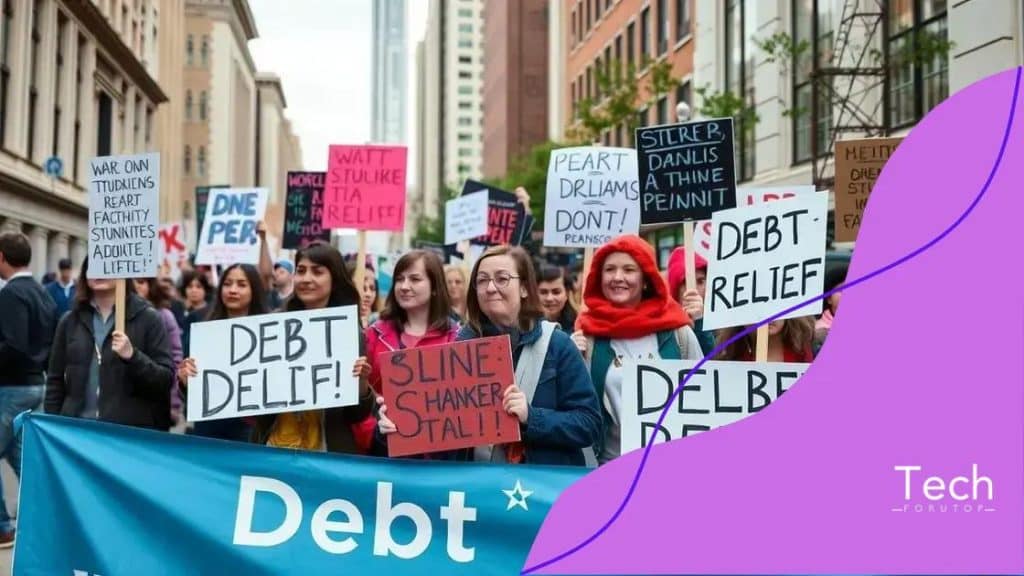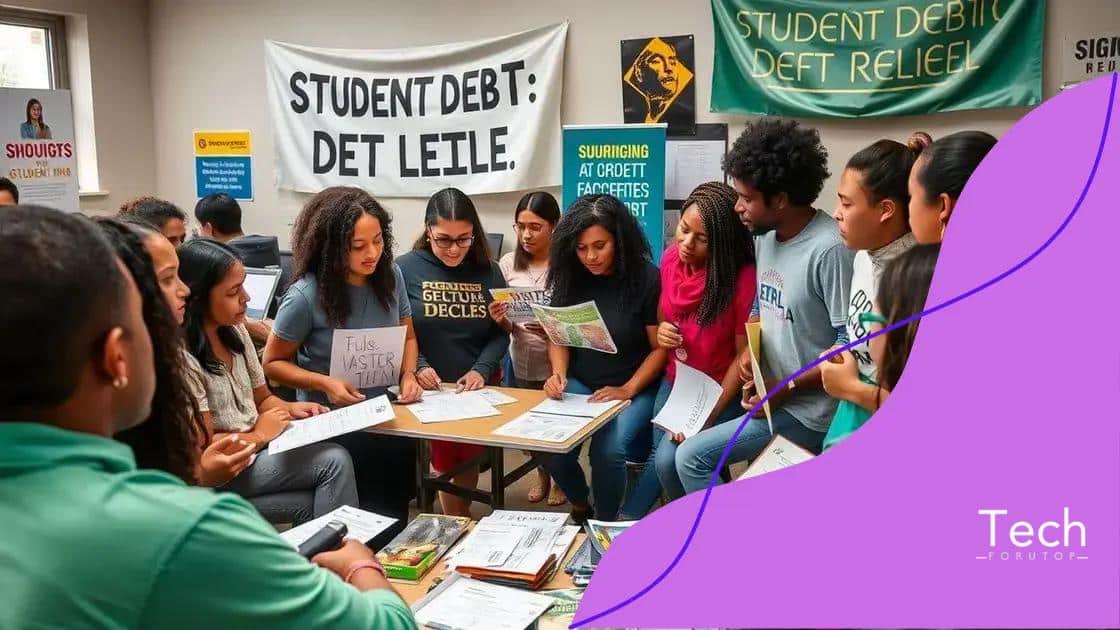Protest campaigns for student debt relief: take action now

Protest campaigns for student debt relief focus on mobilizing individuals to advocate for policies that reduce or eliminate student loan debt, using organizing strategies like rallies, social media engagement, and partnerships with local organizations.
Protest campaigns for student debt relief are becoming a vital tool for change, as students and advocates rally together to address the growing crisis. Have you thought about how these movements affect you?
Understanding student debt relief campaigns
Understanding student debt relief campaigns is crucial in today’s world, where many individuals struggle with the burden of education costs. These campaigns aim to address the overwhelming student debt crisis affecting millions across the country.
What are student debt relief campaigns?
Student debt relief campaigns are organized efforts to advocate for policies that can alleviate the financial strains of student loans. They can take various forms, including petitions, protests, and lobbying efforts aimed at legislators.
Key objectives of these campaigns
- To raise awareness about the negative effects of student debt.
- To influence policymakers to create or reform laws related to student loans.
- To provide support and resources for individuals affected by student debt.
Understanding the impact of student debt relief campaigns on communities is essential. When large groups advocate together, they highlight the issue’s urgency and bring attention to potential solutions. These campaigns help elevate stories of individuals burdened by debt, fostering empathy and support from the public.
Furthermore, they highlight the broader implications of student debt on the economy and social mobility. As awareness grows, it can lead to increased public and political engagement, contributing to meaningful changes in policies.
How individuals can get involved
Getting involved in these campaigns is easier than many think. By joining local organizations, participating in events, or even sharing experiences on social media, individuals can play a part in advocating for student debt relief.
- Join local advocacy groups focused on education reform.
- Stay informed about upcoming protests and sign petitions.
- Share personal stories to help others understand the impacts of student debt.
In conclusion, by understanding student debt relief campaigns, individuals can recognize their power to contribute to substantial societal change. Each voice matters, and together, we can push for policies that lead to fair debt relief options for all.
The impact of protests on policy changes
The impact of protests on policy changes is significant, especially when it comes to student debt relief. Protests can act as catalysts for change, pushing issues into the public eye and prompting legislators to take action.
How protests influence lawmakers
When individuals come together to protest, they create a visible demand for change. This unity can pressure lawmakers to reconsider current policies and think about the voices of their constituents.
- Protests generate media coverage, bringing attention to the cause.
- They highlight the emotional stories behind the statistics, making the issue more relatable.
- Lawmakers may feel compelled to act in response to public pressure.
History is filled with examples where protests have successfully led to policy changes. For instance, when large groups advocate for student debt relief, it can lead to legislative discussions in state and federal government. The attention brought by these movements often reveals the urgency of the crisis and the pressing need to reform student loan policies.
Furthermore, effective protests tend to draw more diverse groups into the conversation, expanding awareness and support. When new voices join the discussion, they reinforce the importance of solutions for student debt relief, making the cause even stronger.
Real-world examples of protest impact
Several movements have successfully resulted in policy reforms following persistent protests. One notable example is the advocacy surrounding the cancellation or reduction of student loan debts, where sustained efforts have led to executive orders and legislative proposals aimed at providing relief.
- The student loan forgiveness programs introduced in various states.
- Changes in federal student loan policies due to public outcry.
- Increased funding for educational grants and scholarships.
In summary, the impact of protests on policy changes regarding student debt relief showcases the power of collective action and the importance of publicly voicing concerns. As more people engage in these campaigns, the likelihood of seeing meaningful change increases.
How to join and support ongoing initiatives

Joining and supporting ongoing initiatives aimed at student debt relief is an impactful way to make a difference. There are many avenues through which you can contribute and help amplify the cause.
Ways to get involved
Engaging with local organizations is one of the most effective methods to show support. Organizations focusing on education reform often host events, create petitions, and provide resources for community members who want to get involved.
- Attend community meetings to learn more about local efforts.
- Follow social media accounts of organizations involved in debt relief.
- Share relevant content to educate your peers.
Participating in rallies and protests is another powerful way to contribute. When you stand with others at these events, you demonstrate a collective desire for change and greater awareness of the issues surrounding student debt relief.
Online activism
In today’s digital world, online activism plays a crucial role. You can support initiatives by signing online petitions, which often lead to significant changes in policy. Many organizations have digital campaigns where your voice can be amplified through just a click.
- Share your personal story online to highlight the impact of student debt.
- Use hashtags to spread awareness on social media platforms.
- Participate in webinars or virtual advocacy events.
Educating yourself and others on the specifics of student debt is another essential aspect of supporting this cause. Understanding the intricacies of policies will empower you to engage more effectively with policymakers and help others grasp the importance of reforms.
Moreover, donating your time or resources to organizations that support student debt relief can significantly help their initiatives. Volunteer opportunities allow you to connect with like-minded individuals who are equally passionate about this important issue.
Real success stories from student activists
Real success stories from student activists showcase the power of collective efforts in achieving student debt relief. These narratives highlight how individuals can inspire change and impact policies that affect their lives and futures.
Inspiring examples
One remarkable story comes from a group of college students who led a campaign to advocate for debt cancellation at their university. They organized rallies, gathered signatures for a petition, and held meetings with school administrators. Their dedication resulted in the university agreeing to provide more scholarship funds to alleviate some of the financial burdens on students.
- Gathered over 5,000 signatures for their petition.
- Partnered with local organizations to amplify their voice.
- Successfully influenced policy changes within their institution.
Another powerful example is a group of high school students who launched a statewide initiative aimed at raising awareness about the impact of student loans. They utilized social media platforms to share stories and statistics, turning their passion into actionable change.
Community engagement and partnerships
By collaborating with local businesses and community leaders, these activists organized events that brought together students, parents, and educators to discuss solutions to the student debt crisis. Their ability to engage the community showed that student debt relief is not just an individual issue; it’s a community concern that requires a collective response.
- Hosted forums that educated the public on student debt.
- Formed partnerships with businesses that supported their initiatives.
- Encouraged local media to cover their events, increasing visibility.
The success of these student-led movements emphasizes the need for perseverance and unity. When students come together, they can achieve remarkable outcomes that many thought were impossible. These stories serve as a reminder that advocacy can lead to substantial policy changes and inspire future generations to continue the fight for student debt relief.
Future of student debt relief movements
The future of student debt relief movements looks promising, as more voices join the conversation and demand change. With the growing awareness around the student debt crisis, these movements are gaining strength and visibility.
Emerging trends in advocacy
One significant trend is the increasing use of technology in organizing and mobilizing supporters. Social media platforms play a vital role in spreading information and connecting individuals who share common goals. These tools enable activists to reach wider audiences and engage with followers in real-time.
- Online petitions can gather thousands of signatures within hours.
- Live-streamed events help people participate from anywhere.
- Hashtags create viral campaigns that highlight critical issues.
Another emerging trend involves the focus on equity and inclusion. Student debt relief movements are increasingly recognizing the unique challenges faced by marginalized communities. Activists are working to ensure that solutions address the disparities in student debt burdens among different demographics.
Legislative prospects
Looking ahead, there are potential legislative changes that could reshape the landscape of student debt relief. Policymakers are more aware of the urgency surrounding student debt, which could lead to new proposals and initiatives aimed at tackling the crisis.
- Discussions about loan forgiveness programs are gaining traction.
- Increased funding for education could alleviate future debt burdens.
- Policies promoting income-driven repayment plans are being considered.
Moreover, the involvement of non-profit organizations and grassroots movements is expected to continue growing. These groups are crucial in educating communities about available resources and advocating for comprehensive reforms. They encourage participation and foster a sense of solidarity among activists and those affected by student debt.
As more students and supporters engage in these movements, their collective actions can lead to significant change in how society addresses student loan issues. The path forward holds much potential for progress in achieving student debt relief and ensuring a sustainable future for students everywhere.
FAQ – Frequently Asked Questions about Student Debt Relief Movements
What are student debt relief movements?
Student debt relief movements are organized efforts by individuals and groups to advocate for policies that help reduce or eliminate student loan debt.
How can I get involved in these movements?
You can get involved by attending local events, joining advocacy groups, signing petitions, and using social media to raise awareness.
What impact do protests have on policy changes regarding student debt?
Protests bring attention to the student debt crisis and can pressure lawmakers to consider reforms and new policies that benefit students.
Can technology help student debt relief movements?
Yes, technology plays a vital role in organizing initiatives, spreading information quickly, and connecting supporters through social media platforms.





